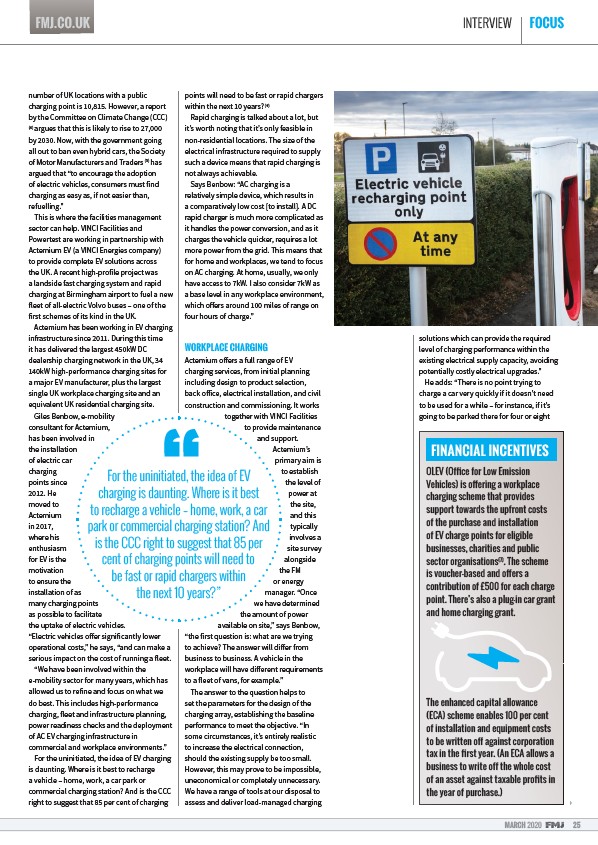
FMJ.CO.UK INTERVIEW FOCUS
solutions which can provide the required
level of charging performance within the
existing electrical supply capacity, avoiding
potentially costly electrical upgrades.”
He adds: “There is no point trying to
charge a car very quickly if it doesn’t need
to be used for a while – for instance, if it’s
going to be parked there for four or eight
MARCH 2020 25
number of UK locations with a public
charging point is 10,815. However, a report
by the Committee on Climate Change (CCC)
(4) argues that this is likely to rise to 27,000
by 2030. Now, with the government going
all out to ban even hybrid cars, the Society
of Motor Manufacturers and Traders (5) has
argued that “to encourage the adoption
of electric vehicles, consumers must find
charging as easy as, if not easier than,
refuelling.”
This is where the facilities management
sector can help. VINCI Facilities and
Powertest are working in partnership with
Actemium EV (a VINCI Energies company)
to provide complete EV solutions across
the UK. A recent high-profile project was
a landside fast charging system and rapid
charging at Birmingham airport to fuel a new
fleet of all-electric Volvo buses – one of the
first schemes of its kind in the UK.
Actemium has been working in EV charging
infrastructure since 2011. During this time
it has delivered the largest 450kW DC
dealership charging network in the UK, 34
140kW high-performance charging sites for
a major EV manufacturer, plus the largest
single UK workplace charging site and an
equivalent UK residential charging site.
Giles Benbow, e-mobility
consultant for Actemium,
has been involved in
the installation
of electric car
charging
points since
2012. He
moved to
Actemium
in 2017,
where his
enthusiasm
for EV is the
motivation
to ensure the
installation of as
many charging points
as possible to facilitate
the uptake of electric vehicles.
“Electric vehicles o er significantly lower
operational costs,” he says, “and can make a
serious impact on the cost of running a fleet.
“We have been involved within the
e-mobility sector for many years, which has
allowed us to refine and focus on what we
do best. This includes high-performance
charging, fleet and infrastructure planning,
power readiness checks and the deployment
of AC EV charging infrastructure in
commercial and workplace environments.”
For the uninitiated, the idea of EV charging
is daunting. Where is it best to recharge
a vehicle – home, work, a car park or
commercial charging station? And is the CCC
right to suggest that 85 per cent of charging
points will need to be fast or rapid chargers
within the next 10 years? (6)
Rapid charging is talked about a lot, but
it’s worth noting that it’s only feasible in
non-residential locations. The size of the
electrical infrastructure required to supply
such a device means that rapid charging is
not always achievable.
Says Benbow: “AC charging is a
relatively simple device, which results in
a comparatively low cost to install. A DC
rapid charger is much more complicated as
it handles the power conversion, and as it
charges the vehicle quicker, requires a lot
more power from the grid. This means that
for home and workplaces, we tend to focus
on AC charging. At home, usually, we only
have access to 7kW. I also consider 7kW as
a base level in any workplace environment,
which o ers around 100 miles of range on
four hours of charge.”
WORKPLACE CHARGING
Actemium o ers a full range of EV
charging services, from initial planning
including design to product selection,
back o ice, electrical installation, and civil
construction and commissioning. It works
together with VINCI Facilities
to provide maintenance
and support.
Actemium’s
primary aim is
to establish
the level of
power at
the site,
and this
typically
involves a
site survey
alongside
the FM
or energy
manager. “Once
we have determined
the amount of power
available on site,” says Benbow,
“the first question is: what are we trying
to achieve? The answer will di er from
business to business. A vehicle in the
workplace will have di erent requirements
to a fleet of vans, for example.”
The answer to the question helps to
set the parameters for the design of the
charging array, establishing the baseline
performance to meet the objective. “In
some circumstances, it’s entirely realistic
to increase the electrical connection,
should the existing supply be too small.
However, this may prove to be impossible,
uneconomical or completely unnecessary.
We have a range of tools at our disposal to
assess and deliver load-managed charging
FINANCIAL INCENTIVES
OLEV (Offi ce for Low Emission
Vehicles) is offering a workplace
charging scheme that provides
support towards the upfront costs
of the purchase and installation
of EV charge points for eligible
businesses, charities and public
sector organisations(7). The scheme
is voucher-based and offers a
contribution of £500 for each charge
point. There’s also a plug-in car grant
and home charging grant.
The enhanced capital allowance
(ECA) scheme enables 100 per cent
of installation and equipment costs
to be written off against corporation
tax in the fi rst year. (An ECA allows a
business to write off the whole cost
of an asset against taxable profi ts in
the year of purchase.)
For the uninitiated, the idea of EV
charging is daunting. Where is it best
to recharge a vehicle – home, work, a car
park or commercial charging station? And
is the CCC right to suggest that 85 per
cent of charging points will need to
be fast or rapid chargers within
the next 10 years?”